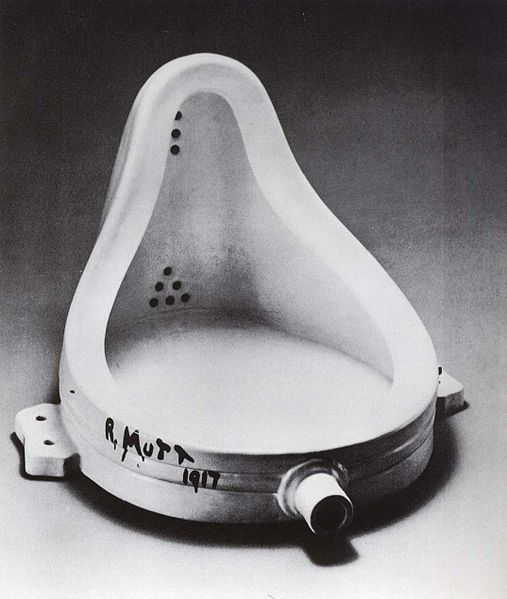Summary of Primitivism
A complex and, at times, contradictory tendency, "Primitivism" ushered in a new way of looking at and appropriating the forms of so-called "primitive" art and played a large role in radically changing the direction of European and American painting at the turn of the 20th century. Primitivism was not so much an artistic movement but a trend among diverse modern artists in many countries who were looking to the past and to distant cultures for new artistic sources in the face of increasing industrialization and urbanization. Beginning at the end of the 19th century, the influx of tribal arts of Africa, Oceania, and Native Americans into Europe offered artists a new visual vocabulary to explore. In many ways, Primitivism provided artists a way to critique the stagnant traditions of European painting. Primitive art's use of simpler shapes and more abstract figures differed significantly from traditional European styles of representation, and modern artists such as Gauguin, Picasso, and Matisse used these forms to revolutionize painting and sculpture.
While on its face, Primitivism was an attempt to embrace and raise the status of tribal arts, it was itself an inherently Eurocentric enterprise and, in many cases, was biased against the very arts it appropriated. Throughout the later 20th century and into the 21st, artists and scholars have attempted to historically contextualize Primitivism and expose its shortcomings as a framework for understanding art from non-European cultures.
Key Ideas & Accomplishments
- As understood by the modern artists, primitive art not only provided new aesthetic forms, it also offered a deeper and more complex emotional and spiritual model that the artists employed to critique the modernization of Western society. Tinged with nostalgia, Primitivism sought connections to a pre-industrialized past in which people were more connected with nature and each other.
- The lasting legacy of Primitivism and the long-enduring assumptions about the inferior quality of art from colonized areas has made it difficult to incorporate African, Aboriginal, and Native American artists into art historical narratives, but attempts at creating a global art history are underway.
- Contemporary responses to Primitivism, often by African American artists and others with a connection to various countries in Africa, are an attempt not to simply appropriate the forms of tribal arts but to explore, recuperate, and reimagine the fullness of African heritage in contemporary society.
Artworks and Artists of Primitivism
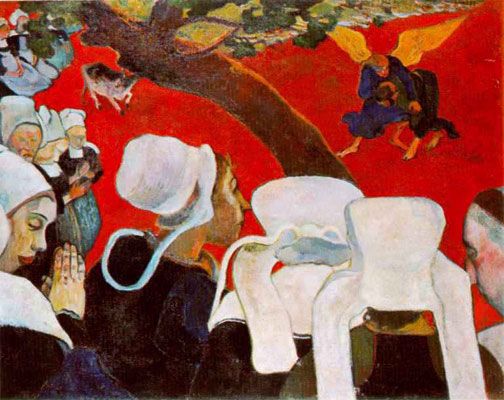
Vision After the Sermon
Gauguin presents the viewer with a visionary scene: women in white bonnets and dark dresses, some of whom have their eyes closed and hands clasped in prayer, stand with their backs to the viewer witnessing a scene from the Old Testament, Jacob wrestling with an angel. Gauguin sets the spiritual vision on a field of red to imply it is not happening in the physical world. The flattened space and simplified forms speak to the new visual language that Gauguin and other Symbolists were developing at the time.
Before Gauguin's infamous South Pacific travels and relocation to Tahiti to escape the suffocating norms of civilized, modern Paris, he and others found relief in Brittany, a rural area of Northwest France famed among artists for the local customs and rituals associated with peasant life. As art historian Gill Perry points out, Gauguin's primitivizing tendencies were well developed in the pictures he painted in Pont-Aven in the late 1880s. Gauguin wrote to a fellow artist about his stay in Brittany, "I love Brittany. I find something savage, primitive here. When my clogs echo on this granite earth, I hear the dull, muffled powerful note that I am seeking in my painting." While overlooking the technological developments and the prevalence of tourists in the area, Gauguin found a supposedly untouched civilization where the peasants, in Perry's words, were "uncorrupted by the sophistication and materialism of the modern world."
Gauguin associated the simplified and flattened forms of his composition with what he thought was the primitiveness of the Breton people. Such abstractions corresponded not to observable reality but an inner meaning that had parallels with the Bretons' religious practices as well as Symbolist aesthetics. Gauguin would use these newly found forms and abstractions to represent similar aspects of the Tahitian culture that he later encountered, famously depicting Polynesian girls and women in eroticized poses in abstracted landscapes and interiors.
Oil on canvas - National Gallery of Scotland, Edinburgh
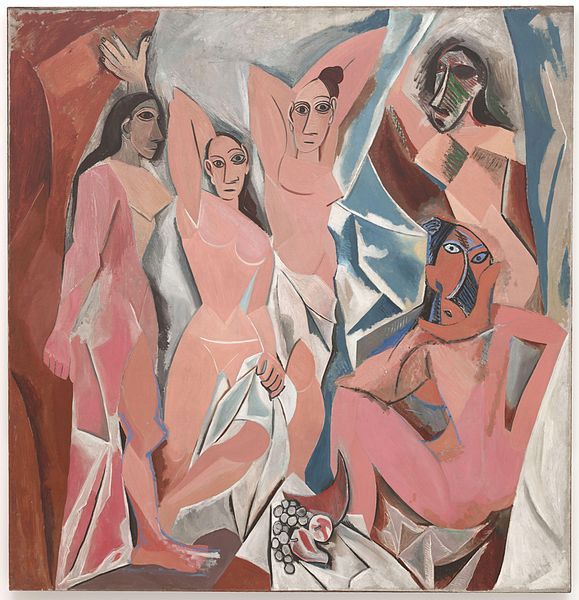
Les Demoiselles d'Avignon
One of the most recognizable paintings of the 20th century, Les Demoiselles d'Avignon depicts five nude females in various poses. Four of the five women look out toward the viewer. Their bodies are angular and rather abstract, and three of them possess mask-like faces. While the setting is stylized, with hints of a curtain and a still life on a low table in the foreground, Picasso's numerous studies make it apparent that the women are in a brothel. In this groundbreaking pre-Cubist work, Picasso combines his studies of Primitive art, namely Iberian and African sculpture, with references to El Greco and Michelangelo to create a new synthesis that would have reverberations throughout the 20th century.
Much has been made of Picasso's appropriation of Primitive art. He already had an interest in the early art from the Iberian peninsula as well as Romanesque art, and around 1906, after a conversation with Henri Matisse and visits to the Trocadéro Museum, he began collecting African sculpture himself. In 1937, Picasso recalled an epiphany he had while visiting the Trocadéro in 1907. While he was put off by the smells and arrangement of the museum, Picasso remembered that when he saw the African sculptures and masks he realized, "The masks weren't like other kinds of sculpture. Not at all. They were magical things.. The Negroes' sculptures were intercessors.. Against everything; against unknown, threatening spirits.." Picasso borrowed the formal qualities of the African masks, such as ovoid shaped faces and angular and geometric facial features, but he also, according to art historian Jack Flam, took in the idea "that the process of making a work of art could be conceived as an integral part of its function." While Picasso was not well aware of the contexts and uses of these masks, he linked the ritualistic and magical properties he assumed they had to his own artistic process when he described Les Demoiselles as his "first canvas of exorcism." The exploration of Primitive art and the rethinking of the creative process set Picasso on the path to develop his analytic Cubist style in which form and space were integrated and Renaissance spatial illusionism was completely abandoned.
Oil on canvas - The Museum of Modern Art, New York
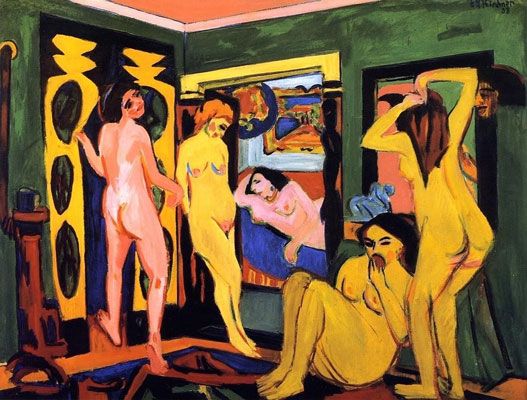
Bathers in a Room
In this large-scale painting, Kirchner transposes the usual idyllic, outdoor site of traditional bathers into his studio, brightly colored and decorated with pseudo-Primitive artifacts and textiles. Tall, dark statues decorate the door jamb in the middle ground, and a boldly colored curtain separates two rooms on the left. In the roundels on the curtain, one can make out a seated king as well as an amorous couple. Kirchner was familiar with African and Oceanic sculptures he saw in the Dresden Anthropological-Ethnographical Museum. While the sculptures and curtain are vague and not specific, as art historian Gill Parry points out, the Primitive objects along with the garish colors, the distortions and angularity of the figures would have signaled a "direct" or "authentic" expression then associated with Primitive, or uncivilized, cultures.
In the 1906 Die Brücke manifesto, one reads, "With faith in progress and in a new generation of creators and spectators we call together all youth. As youth, we carry the future in us and want to create for ourselves freedom of life and of movement against the long-established older forces. We claim as our own everyone who reproduces that which drives him to creation with directness and authenticity." Die Brücke's embrace of the Primitive declared their opposition to bourgeois values and the rapidly industrializing landscape and indicated their mediation between so-called Primitive thought and modern thought and dreams.
Oil on canvas - Saarland-Museum, Saarbrücken, Germany
Little French Girl (The First Step [III])
Brancusi's sculpture of a young girl stands about four feet tall and bears a strong resemblance to certain African sculptures. Brancusi's interest in the Primitive had its origins in Gauguin's Primitivism, which he would have seen at a retrospective in 1906 at the Salon d'Automne, as well as in the sculptures he studied at the Musée de l'Homme, the later incarnation of the Trocadéro Museum, in Paris. Scholars have also pointed to native Romanian folk art as a source of inspiration for Brancusi.
The sculpture recalls several different types of tribal sculpture found in Africa. The elongated neck and spine recall Bambara figures, but the grooves along with the projecting ear and the bell shape of the skirt also resemble Senufo helmet masks from Ivory Coast. An argument has also been made that Brancusi's figure in its armlessness and pinched legs echoes a Bijogo fertility figure. While Brancusi was obviously taken with the formal qualities of African sculpture, it was the Direct Carving in wood that most influenced him. Rather than modeling clay or plaster and then casting in bronze, Brancusi favored direct manipulation of the material of the sculpture. Later in his life, Brancusi remarked "Only the Africans and the Rumanians know how to carve wood." As art critic Sidney Geist points out, Brancusi's emphasis on Direct Carving implied an honesty and authenticity that he thought missing from European sculpture. This sense of authenticity, or genuineness, that Brancusi inferred about African sculpture led him to explore ways in which his art could be similarly direct and unmediated.
Oak on pine base - The Solomon R. Guggenheim Museum, New York, New York
La Belle Jardinère
While the Surrealists were certainly interested in the forms of Primitive art, more than other modern artists, they were deeply interested in Primitive mentalities as they were being studied by anthropologists in the first decades of the 20th century. For example, French anthropologist Lucien Lévy-Bruhl described that Primitive peoples understood the world dualistically, with physical and spiritual realms, and that the spiritual animated the physical. Additionally, Lévy-Bruhl recognized dreams as the crucial place where the two realms intersect. Combined with Freud's theory of dreams, the Surrealists embraced these notions of the Primitive mindset in describing the role of the artist as a sort of magician or shaman who was able to tap into the unconscious realms.
La Belle Jardinère was probably destroyed by the Nazis after being exhibited in the Degenerate Art exhibition in 1937, but in the extant photographs we can see Ernst's burgeoning interests in Oceanic cultures. In this painting, a nude female figure stands atop a tiny landscape. Her torso resembles an anatomical model that would be used in the aid of dissection, and a white bird hovers in front of her pubic region. Additionally, a ghostly outline of a figure stands behind her. Ernst clearly based this figure on an image of a tattooed figure from the Marquesas Islands. Ernst wrote that the Papuan man, who stood for Primitive man in general, "possesses all the mysteries and realizes the playful pleasure in his union with [nature]." Ernst as an artist saw his role as one probing mysteries and delighting in play. As art historian Evan Maurer explains, "What he sought was not some literal communication with spirits and supernatural forces, but rather the ability to give material existence to the images that emerge from the primal recesses of man's creative consciousness." Ernst's appropriation of Primitive arts and ideas exemplified an attempt to redefine what the subject matter of art could be - one's deepest, interior thoughts, feelings, and fears - and to give that subject a new form.
Oil on canvas - Presumed destroyed
Childbirth
In this arresting image, a woman gives birth to a baby while two onlookers stand by her side. Dubuffet rendered the female figure crudely and simplistically. Her arms and hands are raised and her legs splayed, while the baby appears, upside down, below her and between her legs. Dubuffet has tilted the bed on which she lays up toward the surface of the picture, thus flattening the whole composition.
Dubuffet developed an art that looked unskilled and childlike. He looked to the examples of Primitive art as well as art made by children and the mentally ill to find an aesthetic expression that countered traditional Western values. Dubuffet developed the idea of Art Brut, or raw art, or sometimes even "outsider art;" it referred to art, including his own, made outside of academic traditions and by those who did not consider themselves artists. In a 1951 lecture, Dubuffet told his audience that he thought the art of so-called primitive peoples was in fact more sophisticated than Western art, adding "Personally, I believe very much in the values of savagery; I mean: instinct, passion, mood, violence, madness....For myself, I aim for an art which would be in immediate connection with daily life, an art which would be a very direct and very sincere expression of our real life and our real moods." Yet, as the many European artists who came before him and expressed an interest in primitive art, Dubuffet does not acknowledge the indigenous traditions and training that were the context of the art he praised.
Oil on canvas - The Museum of Modern Art, New York
Pictograph
Like his European forebears, Adolph Gottlieb looked to the arts of non-Western traditions to revive what he thought was the stagnant customs of Western art. While not based on a particular object, the images in Pictograph recall female fertility figures, totems, and the abstract designs of rock art. Gottlieb divided the composition, cordoning off each image in a section of an irregular grid. The resulting composition appears to be a puzzle, just hovering above legibility.
Interested in African sculpture as well as the textiles of Northwest Coast Indians, Gottlieb borrowed the simple and geometric forms of these arts to create a new artistic vocabulary. As curator Kirk Varnedoe explained, "Gottlieb's Pictographs insist on a prominently divided field of signs in a way that rejects the cursiveness of automatist 'writing' and evokes not the spontaneous eruption of deep-level flow of consciousness, but a primal ordering impulse and the Primitive mind's ability to hold its elements of meaning in suspension rather than dissolve them in seamless flux." After the atrocities of World War II, Gottlieb, along with several other Abstract Expressionists, turned to Primitive art in an effort to find universal meaning that would provide common ground among isolated individuals. Like many of the earlier modern artists, they sought in Primitivism a utopian and idealistic model of a harmonious society.
Oil on canvas - Albright Knox Gallery, Buffalo, New York
Flexible
Basquiat combined styles and sources, including Expressionism, early 20th-century Primitivism, and graffiti, to create bold and dramatic images that spoke to African history, the plight of African Americans, and the streets of New York City. Here, a black male figure faces the viewer with his arms interlocked above his head, suggesting power and authority. Some have suggested it is a tribal king or perhaps a griot, a figure common in West Africa who would travel from villages and towns telling stories and singing songs.
Art historian Fred Hoffman explains that in Basquiat's paintings around this time the heroic black male becomes king-like and even divine; he suggests, "The figure in Flexible cannot be viewed as a mere mortal. This figure exists beyond our world, a manifestation of a higher power." Basquiat draws the features of the figure - a broad head and nose, almond-shaped eyes with surrounding cowrie shells, and open mouth - from various representations of divine figures that were common in sub-Saharan African cultures. While earlier 20th-century artists borrowed forms from African sculptures, Basquiat does so with full knowledge of their context and history, transposing the power and sacredness of such figures to contemporary depictions of black males.
Acrylic and oilstick on wood - Private Collection
Beginnings of Primitivism
The term "primitive" derives from the Latin, meaning "the first or earliest of its kind." Travelers to the South Seas and Africa brought back tales of new cultures that little resembled what Europeans knew or valued. Europeans admired these new cultures for their exoticism but also looked down upon them, understanding them to be essentially "uncivilized" in their manners and customs. As art historians Mark Antliff and Patricia Leighten point out, the label "primitive" does not exist without the idea of the "civilized." The two terms are necessarily relational and create an ideological construct that renders what is primitive lacking in sophistication, but the interest in the primitive also pointed to a nostalgic tendency to prioritize a pre-industrial past in which one's relation to nature was primary.
“The Noble Savage” Emerges
The interest in the Primitive was prevalent in modern European culture and defined a new tendency in both philosophical and cultural realms. During the 18th century, philosophers explored the dichotomies between the rational and the irrational, the natural and the artificial, forcing individuals to question their own places in the civilized world. With increasing urbanization and the beginnings of industrialization, Enlightenment authors Johann Gottfried Herder and Jean-Jacques Rousseau promoted the idea of the primitive way of life, detaching from technological and cultural developments that allowed for a more organic rhythm and equilibrium with nature. This desire for a new simplicity of life was further connected with the idea of "arcadia," thus establishing the primitive as a sort of lost paradise.
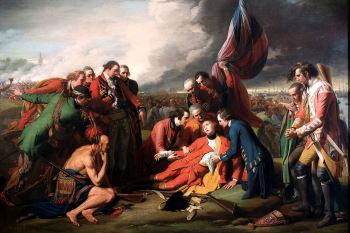
The idea of the "noble savage" circulated widely during this era, which many saw to be a decline from earlier times; society had become corrupt, led by men defined by greed, egoism, and desire for power. The primitive man, who is supposedly in closer contact with nature, was understood to be superior in conduct and goodness to the modern, corrupt man.
As modernity set in, people, and especially artists, began to react against the urbanization and industrialization they experienced. Artists began exploring other civilizations and cultures to counter the Western traditions they thought constricting and moribund.
Primitivism and Art: Late 19th Century
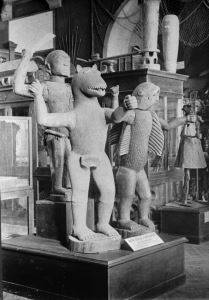
Sculptures and masks from Africa as well as Oceania and objects from Native American tribes made their ways into museums across Paris, London, and Berlin and were exhibited in world fairs for the larger public to see. In 1878, the Trocadéro Museum, Paris' first ethnological museum, opened. The museum housed a collection of artifacts from across the globe that were thought to be vanishing in the wake of colonization. These artifacts, now divorced from their original cultural contexts, were not considered art in the European sense, but for precisely this reason, many artists, who were searching for qualities and attributes that opposed the classical, rigorous Academic traditions, turned to these objects for inspiration and confirmation of their own aesthetic experiments.
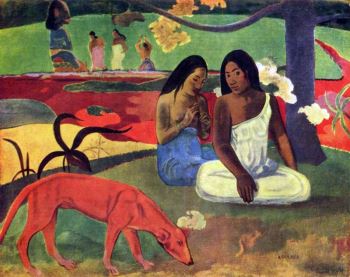
Many trace this tendency toward Primitivism to Paul Gauguin, who employed flattened decorative effects and stylized forms that were similar to the objects he encountered in museums and on his travels in Tahiti and Hawaii as well as closer to home in Brittany, the rural area of France that had become popular with artists in the mid-19th century. The local customs and religious rituals recalled an earlier time for which the artists and other urban dwellers were nostalgic. Gauguin's fascination with these other cultures prompted him to further push his aesthetic explorations in even more radical directions. Not happy with the observational approach of the Impressionists, Gauguin and other Symbolists wanted to convey ideas and emotions through line and color, manipulating rural and exotic subject matter.
Adoption of Primitive Art: Early 20th Century
Diverse artists, including Henri Matisse and the Fauves, Edvard Munch and James Ensor, along with a range of German Expressionists, discovered in Primitive artifacts a more basic language of form that was more in line with expressing the emerging modern experience than the norms of the national academies.
In 1906, Matisse bought a small African sculpture, now identified as a Vili figure from the Democratic Republic of the Congo, at a small shop on his way to visit Gertrude Stein's home and thus introduced his friend and rival Picasso to African art. After this initial contact, Picasso began visiting the Trocadéro, becoming fascinated with the African Fang masks in particular. His appropriation and exploration of the formal aspects of Primitivism aimed to reshape art altogether. Picasso's early Cubist work Demoiselles D'Avignon (1907) is perhaps one of the most famous examples of modern art's appropriation of primitive art forms, even though Picasso later dismissed the influence.
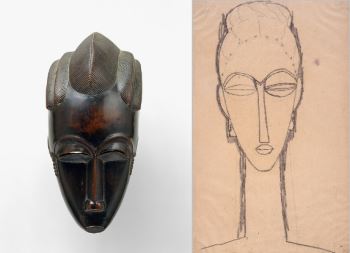
Amadeo Modigliani was inspired primarily by the masks of the Baule peoples of the Ivory Coast, making sketches of their heart shaped forms and narrowed chins, and his studio neighbor Constantin Brancusi saw affinities between the wooden masks and the sculptures of his native Romania. These simplified forms became the basis for his radically reduced sculptures.
In Germany, Der Blaue Reiter and Die Brücke groups also embraced Primitive art. Kandinsky and Franz Marc saw African sculpture at the Ethnographic Museum in Berlin as early as 1907. Kandinsky, instead of being inspired by specific forms, embarked on a path to assimilate all artistic expressions. As art historian Donald Gordon explains, "For the Blaue Reiter, 'the primitive' could just as readily signify Archaic court art, folk art, or children's art as it could tribal art." The artists of Die Brücke, on the other hand, embraced Primitivism whole heartedly, not just borrowing artistic forms, but creating a whole lifestyle around ideas they associated with Primitivism. Again, Donald Gordon describes, "In city studios artists re-created the imagined environment of tribal life. And in the countryside the life style of peasants was appreciated for its own sake. Some artists even 'went native' during summer vacations, living in the nude with their models and practicing a sexual camaraderie that paraphrased - so they thought - the supposed instinctual freedom of tribal life."
American artists like Max Weber and Marius de Zayas traveled to Europe and saw first-hand the influence of tribal art on the avant-garde. Weber himself began collecting African sculpture and sometimes included pieces in still life paintings, and de Zayas brought back African sculptures for Alfred Stieglitz, the photographer and gallerist. Stieglitz greatly contributed to the early diffusion of Primitivism in America by showing the works of Matisse, Brancusi, and Picasso side by side with African sculpture and Mexican pottery.
In the 1920s and 1930s, philosopher Alain Locke and others emphasized the importance of African American artists using African art as inspiration. Instead of appropriating the forms without consideration for their original contexts, artists of the Harlem Renaissance, such as Aaron Douglas and Beauford Delaney, drew from African art and history and combined their explorations with modern avant-garde forms to create a new vision of and for modern African Americans
Later, Surrealist artists also grew fascinated with primitive art, although they preferred Oceanic and Native American art over African art. As art historian Jack Flam argues, the Surrealists were "more interested in the invisible forces contained within primitive art than they were in its formal innovations." They thought these primitive peoples were more in touch with the spiritual world and offered an example to escape from Western materialism and tap into a universal language via the subconscious.
Goldwater's Types of Primitivism
American art historian Robert Goldwater wrote Primitivism in Modern Art in 1938, the first study of how modern artists borrowed from primitive art. Goldwater explained, "The primitive is conceived and reached by stripping off later layers of unessential accretion in order to reveal a pure homogeneous core." In this sense, the primitive is equal to a "simple uniformity," expressed directly with the material without preparatory drawings or musings. Within this basic definition, Goldwater elaborated various types of primitivism within modern art, depending on how the artists approached primitive art.
He described the works of Paul Gauguin and the Fauves, especially of Henry Matisse, as "romantic primitivism." Goldwater argued that it was the external forms of primitive cultures that influenced the styles of Matisse and others. The artists reduced their subjects to their essential, external forms, and often they portrayed the nude human figure in harmony with the landscape or the environment, suggesting a sense of natural balance that countered industrialized and urban society.
Goldwater identified the German Expressionists, especially the works of Kirchner and Die Brucke group, with "emotional primitivism," "an interiorization of the conception of the primitive." After viewing Gauguin's exhibition in Dresden in 1910 and their own experience of tribal arts, these artists focused on the understanding and revealing of primal and extreme emotions they perceived in primitive art forms.
Goldwater defined an "intellectual primitivism," mostly associated with Picasso, that seemed to sustain a more rational and formal approach. For Picasso, primitive art was about formal dialogues, geometric languages, and the intangible aspects embodied in the objects.
Finally, Goldwater located a "subconscious primitivism" in the art mostly composed from 1920 onwards, specially defined by the Dadaists and by the Surrealists. The primitive seemed to allow subconscious impulses to drive the creative process freely, greatly inspiring the Surrealists who began to explore an "automatic" approach to the creative process.
Primitivism: Concepts, Styles, and Trends
Primitivism and Orientalism
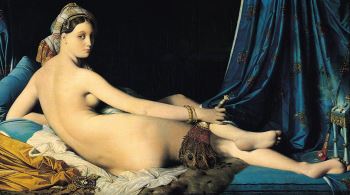
During the 19th century, with increased travel and Napoleon's invasion of Egypt in 1798, European artists became fascinated with the Eastern cultures of Asia, the Middle East, and North Africa. There was a growing market for objects, including textiles, pottery, and fashion from these countries, and artists such as Delacroix and Ingres depicted exotic, and often eroticized, scenes of harem women and everyday life. Using vibrant colors, the artists rendered naturalistic scenes that were often imaginary or a composite of various elements and that perpetuated Western stereotypes of the East. Orientalism, rooted in imperialist attitudes, often depicts the non-European Other as uncivilized or irrational, thus justifying European involvement in that culture.
These early fascinations with Eastern cultures run parallel with Primitivism. Both are premised on a sense of European superiority, and both are constructed with complex, and often contradictory, techniques of appropriation and representation. While Orientalism's fascination is with developed countries, Primitivism is a fascination with early stages of cultural development. Primitivism, in this sense, involves a return to a, presumably, more perfect state of existence with nature.
Primitivism, Child Art, and Naïve Art
In many ways, the interest in Primitivism dovetailed with the interest in child art. Without any formal training, the art made by children does not conform to pre-established rules and traditional conventions. At the turn of the 20th century, artists and critics likened children's drawings to the art of primitive peoples in their innocence and instinctiveness. Franz Cizek, a Viennese artist, claimed in 1885 that children created art with an intrinsic aesthetic value, and he promoted free expression and the use of imagination in teaching children. For artists such as Matisse, Picasso, Chagall, Kandinsky, and Klee, who were exploring abstract forms devoid of narrative function, children's drawings were exemplary of a process of creation that was not overly intellectualized and seemingly more direct. A process that they themselves were trying to develop.
In addition to rethinking the creative process, children's drawings also appealed to artists in their way of perceiving the world. Marc Chagall's whimsical forms and compositions were influenced by children's art, and he created a sort of fairytale world using relatable and intuitive symbols.
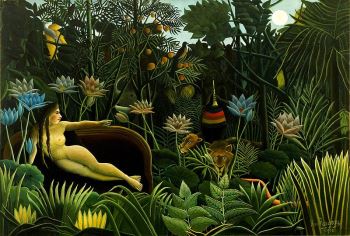
It was in this context that Naïve art, sometimes called folk or outsider art, also became an important source for artists. For the most part Naïve artists were self-taught and, like primitive and child artists, created images outside of the mainstream European traditions. Often Naïve art possesses a childlike simplicity of perception and technique. Henri Rousseau, a toll collector for much of his adult life, was the most famous Naïve artist of the time, garnering the admiration of Paul Signac, Kandinsky, and Franz Marc among others. His dream-like scenes of jungles and landscapes evoked a sense of wonder and strangeness associated with a childlike perspective. Naïve artists were often referred to as "modern primitives," emphasizing the intellectual underpinning of how people thought of this art.
Primitivism and Art Brut
The theoretical underpinnings of Art Brut, or raw art, owe much to the way artists and critics thought of primitive and naïve art. Coined by the French artist Jean Dubuffet in 1948 to refer to his own creations and to a series of other art forms he was collecting, the term aimed to capture the intuitive, rough, expressive, and often grotesque visual language that differed significantly from traditional and academic norms. Art Brut also embraced the art of the mentally ill, art made by prisoners, and graffiti in an effort to subvert high art and to reach the common person. In particular, Art Brut was a response to the brutality and horrors of post-World War II Europe. With cities across Europe bombed to rubble and tens of millions of people dead by wartime atrocities, fighting, and famine, the suffering of those who survived was palpable and raw, and Art Brut sought to find a language to express that pain.
Dubuffet and Picasso collected the work of Scottish painter Scottie Wilson, which Dubuffet saw as exemplary of Art Brut. His work, greatly admired during the 1960s and the 70s, used primitive symbols and naturalistic themes. His work became widely recognized at the forefront of Outsider art. The term 'outsider' was initially used by art critic Roger Cardinal, and eventually became synonymous with Art Brut, linking it with Child art, Naïve art and Primitivism.
Later Developments - After Primitivism
The MoMA Exhibition of 1984
The Museum of Modern Art in New York opened a major exhibition entitled Primitivism in 20th Century Art: Affinity of the Tribal and the Modern. The show featured works from leading European and American artists, stretching back to Gauguin and forward to the Abstract Expressionists and more contemporary artists. The paintings and sculptures were exhibited next to the African, Oceanic, and indigenous pieces that bore similar formal properties.
While the curators intended the exhibition to be a straightforward consideration of which modern artists saw which African and tribal artifacts when, the exhibition instead set off a flurry of serious critiques. Primarily, the critics of the show felt the curators used the unattributed and decontextualized arts of the tribal cultures as simple fodder for modern artists instead of works of art in their own right. Art historian Monica Blackmun Visonà summarized the critiques by explaining that the most egregious implications of the MoMA show was that only the modern European artists were clever or capable enough to borrow ideas and form from other cultures, thus denigrating the artists of Africa, Oceania, and other places.
One of the most outspoken critics of the show, Thomas McEvilley, pointed out that the curators tightly controlled the viewer's experience of the selected works through arrangement and accompanying wall texts so that the modern European artists were seen as creative and original and not mere appropriators of other cultures' art.
Black Art, Ancestral Legacy: The African Impulse in African-American Art
In 1989, the Dallas Museum of Art attempted to rectify some of the controversies of MoMA's Primitivism show with the exhibition "Black Art, Ancestral Legacy: The African Impulse in African-American Art." Focusing on trained and self-taught artists from the United States, the Bahamas, Jamaica, Haiti, the show explored the various ways in which these artists embraced and responded to African art in terms of legacy, reclamation, private visions, and festival and ritual, the four broad categories in to which the art was divided. Additionally the exhibition underscored the importance of Historically Black Colleges and Universities as well as individual trips to Africa in the propagation of African tribal arts among African American artists. With this exhibition the full depth and range of African art was brought into relationship with modern and contemporary artists who were doing more than appropriating formal vocabularies.
Magiciens de la Terre
Also in 1989, the Centre Georges Pompidou in Paris launched an ambitious exhibition, Magiciens de la Terre (Magicians of the Earth), as a postmodern response to MoMA's 1984 exhibition. Attempting to break the cycle of Eurocentric views of non-European art, only half of the artists exhibited were artists from Western countries while the other half were from non-Western countries. The curator Jean-Hubert Martin set out to put artists from the centers and the margins on equal footing, thus confronting previous assumptions of colonial mentality.
This show, too, was met with criticism. Many complained that it was too romantic and that "magician" had implications of irrationality and otherworldliness . Others lamented the lack of acknowledgment of the political institutions and attitudes that perpetuated colonial stereotypes for so long. As Thomas McEvilley wrote, "The Magiciens show hoped to be able to acknowledge that value judgments are not innate or universal but conditioned by social context...," but in the end only relativized the problem.
Primitivism and Contemporary Art
In his essay on contemporary art for the 1984 MoMA exhibition, Kurt Varnedoe suggested that the legacy of early-20th-century Primitivism lived on in works by the Earthworks artists such as Robert Smithson and Michael Heizer in addition to Process artists like Eva Hesse. He argued that while they were not interested in borrowing forms from tribal arts, they were interested in probing forms that suggested "both germinal origins and irreducible essences of experience." To counter Varnedoe, art critic Thomas McEvilley thought that if one were to talk of contemporary Primitivism, it would make sense to look to the constructions made by Michael Orr and Michael Tracy that evoked shamanic and fetishistic objects made of human hair, blood, bone, semen and other "taboo materials" as well as performances by Hermann Nitsch, Paul McCarthy, Kim Jones, and Gina Pane that explore the human body, spirituality, and ritual in ways that, in the words of curator Kurt Varnedoe, "bring up 'uncomfortable questions about the ultimate content of all ideals that propose escape from the Western tradition into a Primitive state.'"
The 1980s Neo-Expressionist Jean-Michel Basquiat newly mined the forms of Primitivism and Naïve art to explore his connections to African history and to confront issues of race and class in the art world and society at large. Appropriating the appropriators, Basquiat called attention to the ways in which African and African-American history were whitewashed.
Contemporary artists of the African Diaspora have questioned historical and contemporary migrations from the African continent. Artists such as Wangechi Mutu, Chris Ofili, El Anatsui, and Yinka Shonibare explore the impacts of Western art on various African traditions in addition to ideas of hybridity, travel, environmental waste, and appropriation to turn earlier ideas of Primitivism on their head.
With the late 20th century exhibition controversies and attempts to rectify the understanding of Primitive art, late 19th- and early 20th-century concepts of Primitivism were exposed to be problematic, but artists continue to question the results and implications of the rampant industrialization and technologization of Western society that have left people feeling unconnected and isolated. Recuperating the contexts of African and non-European arts and plumbing their histories and connections have created new opportunities to reassess and think through 20th century Primitivism.
Useful Resources on Primitivism
- Primitivism and Twentieth-Century ArtOur PickEdited by Jack Flam and Miriam Deutch / A Documentary History
- Primitivism in Modern ArtOur PickBy Robert John Goldwater
- Primitivism and related ideas in AntiquityBy Arthur Lovejoy and George Boas
- The Sleep of Reason: Primitivism in Modern European Art and AestheticsOur PickBy Frances S. Connelly
- In Search of the PrimitiveBy Stanley Diamond
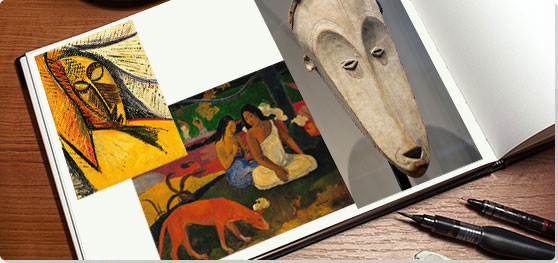








![Constantin Brancusi: Little French Girl (The First Step [III]) (c.1914-18)](/images20/pnt/pnt_primitivism_4.jpg?1)




